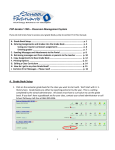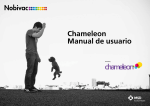Download User Guide Getting started using the LLTTF Interactive package Dr
Transcript
User Guide Getting started using the LLTTF Interactive package Dr Chris Williams Helping you to help yourself Written by Dr Chris Williams. Used under licence ©2010 Welcome…. Welcome to Living Life To The Full Interactive - LLTTFi. The aim of this course is to help give you the information you need to start feeling better. Signing on and registering To get started you need a user name and password. You will probably have been given this by the healthcare practitioner who recommended you to this course, You also need an internet connected computer (broadband), a soundcard, access to a printer and a web browser. Living Life to the Full recommends the use of the FREE Firefox Web browser but any will do. You can download the browser for free from www.getfirefox.com. You can choose not to make it your default browser. Go to the web address on your user login/prescription card. On the login screen fill in the user name and password boxes and copy the letters and numbers of the security code into the box and then click the login button. Please complete these exactly- using the same case and not adding any spaces or hyphens. If this is the first time you have logged in, you will then be asked to fill in some brief information about you as you register for the course. Click on each category and then select the answer most appropriate to you. When you have finished your answers click next. Written by Dr Chris Williams. Used under licence ©2010 The Main menu screen You will now be on the main menu screen. Have a look around and click on the various buttons. Before starting each session you can print off or save/download the relevant session handout (workbook) which will give you space to make your own notes as you go through the session, list the key points of each session and give you a reminder of the homework each session. Written by Dr Chris Williams. Used under licence ©2010 To access the session click the Course Menu button. The program will check the speed of your connection – just let it do this for a short time. When this is complete click the continue button. The Course Menu button takes you to a list of sessions. We recommend you start at Session 1 and work through sessions about once a week. A key to success is really thinking about how what you learn affects you- and also putting what you are learning into practice. Each session contains information, examples of people using the approach on video, and asks you questions to help you work out how this applies to you. Sessions last from 25-45 minutes. When you have completed a session, you can review it again by clicking on it. If you stopped halfway through a session it will allow you to start at this point. Written by Dr Chris Williams. Used under licence ©2010 Click Start and start the program. Please note, depending on how your practitioner/organisation has requested the package is set up you will either be able to use sessions at any time, or you may find that subsequent sessions are left locked until a week after completing the previous session. Please inform your practitioner if you prefer access to all modules. The reason why often the progress is locked so you do sessions 1-6 in order – spread out over weekly intervals is to force you to slow down and try to apply what you learn – rather than reading things and perhaps not getting focused on change. Written by Dr Chris Williams. Used under licence ©2010 Controlling the sound and video The first screen plays a video. To see the controls for the video hover the cursor over the video picture. The bar at the bottom allows you to pause and play the video, using the buttons at the left hand side, and to adjust the volume using the slider at the right hand side, which appears when the button at the right hand side is clicked. Hint: make sure your speakers are plugged in, powered up, the volume is turned up, and the volume is not muted- check if the little audio speaker at the bottom right of your screen has a red cross through it- in which case right click that speaker and unmute it. The numbers at the top right hand side tells you how long the video is and how much has already been played. As you go through the screens, some screens will ask you questions. Try to use these to help you stop, think and reflect on what you are learning. Make brief notes, and write down key things you are learning so you don’t forget them. Try to answer all the questions, and listen to the video- and see which insights are helpful for you. Putting into practice what you have learned At the end of the session you will find one or more suggested tasks to complete over the week between sessions. They are there to encourage you to practice the new skills, and test out how it works for you. One of the biggest challenges to moving things forwards is simply practicing – and remembering to keep working on things. Written by Dr Chris Williams. Used under licence ©2010 Set a reminder: Because of that a helpful feature on the main Course Menu allows you to arrange a text or email reminder to be sent to you at a set time over the next week or so. We recommend you use this option to help remind you, and keep you on track. Two other key things will help you get the most from the course. Having a plan to put what you learn into practice Receiving support and encouragement from others to help you stay on track. The Plan, Do, Review approach Having a plan of what you are going to do, and when you are going to do it is important. Two key sheets accompany the course. A Planner Sheet, and a Review Sheet. The Planner sheet helps you to make plans to both login to do the next module- and also to do the various homework/putting into practice tasks. You can use it to plan any activity. The key is to have just one small target. The Review sheet then helps you reflect a week later (or any time after the plan) on how the Plan went. It asks whether you completed the plan or not, or whether there was a problem such as forgetting, or being knocked off course by something unexpected. The key is that it isn’t a disaster if you forget or have problems with a module. The key is to use the Review sheet to reflect on the difficulty, and come up with a better problem-solving plan for next time. The good news is that you will get better and better at this as you work through the package. Can we therefore really encourage you to get into a regular routine pattern of Plan (with the Planner sheet), Do (or not!) and Review (with the Review sheet). Copies of the Planner and Review sheet are included on the next two pages. Can we suggest that you take the opportunity now to complete a Planner sheet to plan when you will do your first or next session of LLTTFi? Practical Hint: Print off the Planner and review sheets along with the session handout for each session and then use them by yourself- or with your practitioner, to review progress, learn from how things are going, and make the next plan. Written by Dr Chris Williams. Used under licence ©2010 1. what am I going to do? planner sheet Don’t just sit there, make a plan! Is my planned task - date yes no Q. useful for understanding or changing how i am? © Dr Chris williams (2010) All rights reserved www.livinglifetothefull.com 2. when am i going to do it? 3. what problems or difficulties could arise, and how can i overcome them? yes no Q. specific, so that i will know when i have done it? Q. realistic, practical and achievable? mood rating score (if applicable) my next contact time Re-arrangement details: Remember - if you know in advance you can’t make the session, please let us know by contacting your local support worker. PLEASE NOTE: If you are struggling or feel worse, or if at any time you feel suicidal please visit your doctor or go to A&E or phone NHS 24/Direct yes no what did you plan to do? write it here © Dr Chris williams (2010) All rights reserved www.livinglifetothefull.com did you try to do it? yes no if yes: review sheet Ok, how did it go? For discussion dated: 4. how are you going to apply what you have learned? if no: what stopped you? internal things (forgot, not enough time, put it off, didn’t think i could do it, couldn’t see the point etc.). 1. what went well? external things (other people, work or home issues etc.). 2. what didn’t go so well? how could you have planned to tackle these things? 3. what have you learned about from what happened? Getting Support We know how easy it is to become discouraged and stop working on courses such as this. Part of feeling down and low means that we have low energy, concentration, easily can get distracted, and may quickly lose motivation- especially if there are setbacks. We strongly recommend that you seek out and take up offers of regular support and encouragement from your practitioner/support worker. Also get trusted family and friends in on supporting you. But don’t pick people who you know will get at you, nag you or criticise you. Whoever supports you, use the Planner and Review sheets to help build slow steady steps forwards. Practical hint: In some versions of LLTTFi there is access to a support forum where other users can provide answers, support, hints and tips online. If this is present in your Course Menu then have a look around and say Hi! There are some more free hints and tips on how to use this support approach at www.fiveareasonline and the Write all over your bathroom mirror book is especially recommended. If you need Urgent help Part of feeling stressed and down means that it is easy sometimes to feel worse. That may be because something bad has happened or we face hassles or difficulties, or sometimes we can just feel worse for no clearly obvious reason. If you find you are feeling worse, or stuck then please tell your practitioner or support worker and let them know. If you feel suicidal or hopeless, then you need to get help now. Your Practitioner will have given you details of how to get local help when introducing you to the package. Key options include: Your Practitioner Phone the emergency Number (e.g. 999 in the UK) Go to Accident and Emergency (the Emergency Room) The package itself is not enough if you feel suicidal. You need to go somewhere where you can receive the right kind of support. More Urgent support: You will find some UK- specific contact supports in the Appendix at the end of this short booklet. Written by Dr Chris Williams. Used under licence ©2010 Some Final Thoughts The course has helped many many people. Hopefully you are feeling excited and ready to start. Or perhaps you’re not so sure, and are a bit sceptical. However you are going into things remember these three things and you’ll hopefully gain a lot: 1). You’re going to learn some new information that can really help 2). Applying what you learn in your own life is key. Use the Pl, Do, Review model to help you do that. 3). You’re bound to get stuck, or feel confused at some time. When you “hit the wall” like that, keep in there. Use your supports (practitioner, family, friends) to help you stay on track. If you have a bad patch it can be easy to say “oh I give up!”. Please don’t, but realise that getting better is about ups and downs. We really hope this course can help you move through that towards feeling better. Dr Chris Williams MBChB BSc MMedSc MD Professor of Psychiatry, University of Glasgow, Scotland, UK Other five areas resources: www.fiveareas.com (book shop and resources) www.fiveareasonline.com (online books to read) Appendix UK-based additional support options if you feel worse and need extra help Your own GP or the Accident and Emergency department at your local hospital The Samaritans (24 hours) Telephone 0845 7 90 90 90 or Email: [email protected] NHS 24 for Scotland (24 hours) Telephone 0845 4 24 24 24 NHS Direct for England and Wales (24 hours) Telephone 0845 4647 Breathing Space: Telephone 0800 83 85 87 6pm - 2am (Monday to Thursday) 6pm - 6am at weekends (Friday, Saturday, Sunday) Help in Northern Ireland The Samaritans 5 Wellesley Avenue, BELFAST BT9 6DG, County Antrim, Telephone: 028 90664422 Lifeline Charity Telephone: 0808 808 8000 for people of all ages in crisis or despair. Written by Dr Chris Williams. Used under licence ©2010 Interactive Technical Stuff Logging-in: All you really need to get started, is an Internet connected computer and a Web browser. Living Life to the Full Interactive recommends the use of the FREE Firefox Web browser but any will do www.getfirefox.com Other software that you will need includes: Adobe Flash Player to play the video and animations on the web. Adobe PDF Reader to view and print handouts. You can download the software for FREE from the site. Use your user/prescription card details to login. Please type in details exactly as on the card- as the login details and password are case specific. LLTTFi Quick Start Guide What is Living Life to the Full Interactive? LLTTFi is an online life skills course based on the proven cognitive behavioural therapy (CBT) approach. It aims to provide a practical and accessible route to feeling better. Technical difficulties: The Technical Support section at the top of the home page will guide you through the log-in process and other aspects of the site. Getting the linked workbooks: You can get the linked handouts for each section from the Downloads area of the site. Please print it off before starting each session. How private is your information? Your personal information will only be available to your clinician and other approved clinical and site administrators. Anonymous grouped results of the impact of the package are summarised by Media Innovations on a regular basis for clinical outcome audit. See the Privacy and Privacy Policy for further details. Write your PASSWORD here: The course offers: Practical modules cover areas commonly affected by low mood and tension Text and video put together in the package to address your situation Teaching important skills such as relaxation and how to challenge negative thinking Hints and tips for making changes Easy to use, understand and apply approach that can make a real difference. About the LLTTFi site The site contains materials written by Dr Chris Williams who works at the University of Glasgow. You can login using a computer at home, a library or internet café. Each session lasts about 45 minutes – and you can stop and rejoin any session whenever you want. Most people using the site have found it helps them tackle feelings of depression. Additional features include the site forum, ability to send email/text reminders to login, and importantly Planner and Review sheets to help you Plan, Do and Review your sessions Course Content and Materials What would you like to get out of the course? What is contained in the course? Clearly presented information that will help you find out why you feel as you do. You will discover how to make changes in your life – using evidence-based tools that are based on a cognitive behavioural therapy (CBT) approach. This is an evidence-based form of therapy. You will learn key life skills to help you to turn the corner. Sessions are delivered online and use cutting edge multimedia design covering: Session One: What is Depression? Session Two: Getting Started: Creating an Action Plan Session Three: Identifying extreme and unhelpful thoughts Session Four: Challenging extreme and unhelpful thoughts Session Five: Learning New Skills (problem solving/ assertiveness) Session Six: Planning for the future We all need life skills in our work, relationships and in every other aspect Your practitioner will be there along the way – helping you get the most out of the course- and to really apply it in your own life. use the course on a regular basis. We know quite how hard it can be to stay of our lives. Probably we all have very different reasons for doing the course. Some may be experiencing low mood, depression, anxiety or distress. Whatever your reason for wanting to learn these life skills we hope the content proves helpful. The skills taught cover general skills/information we can all use in our lives when we feel under pressure, stressed or distressed. Remember: To get the most out of the approach we advise that you try fully complete and practice using the modules and make a commitment to motivated when you feel down and stressed. Your practitioner/support worker will be there with you to help you get the most from the approach. What others have said about other the five areas approach: “The wording is so simple and easy to understand - no long 'technical' terms! Thank you very much.” How to get in touch: Write your practitioner details here: Features of Living Life to the Full Interactive (LLTTFi) Sound, text and video clips are used throughout. Free short handouts supplement the course. Set up text and email reminders to help you keep focused. Regular contacts with your practitioner help you keep on track. Clear Plan, Do, Review model helps you keep on track. Name: Address: Telephone: Record also what they have advised you to do if you feel worse and need urgent help



















